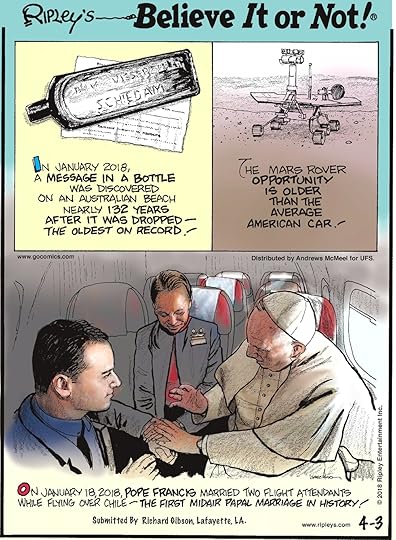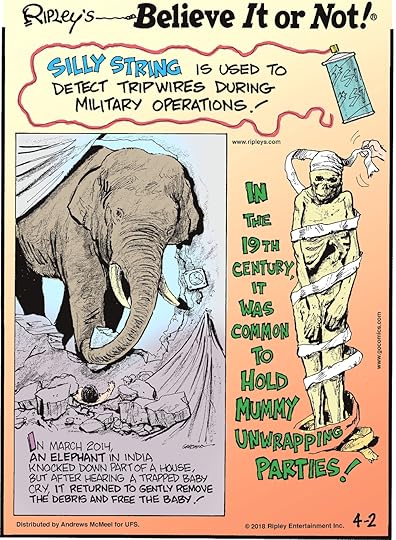Ripley Entertainment Inc.'s Blog, page 352
April 4, 2018
CARTOON 04-04-2018
April 3, 2018
Zerelda James, An Unbelievable Case of Motherly Love
Featured in Ripley's Believe It or Not!

A crook only a mother could love, Jesse James was born in Clay County, Missouri, on September 5, 1847, to Robert and Zerelda James. Zerelda had her hands full with Jesse and his older brother Frank, among other siblings. This was a case of motherly love…taken to the grave!

Zerelda, Jesse and Frank James
When the Civil War called, young Jesse watched Frank march off to fight for the rebellion. In 1864, as a teenager, Jesse himself rode off to join the Confederate guerrillas.
When the war ended, Jesse and Frank kept going—acting as modern-day Robin Hoods—robbing trains, banks and stagecoaches, and committing crimes of a much darker nature long after. These actions cost their dear mother, Zerelda, an arm and a leg—nearly literally.
They Cost Their Mother Her Arm
Wild West bounty hunters, the Pinkerton Detective Agency was famous for infiltrating the Reno gang, the group behind the country’s first train robbery, and chasing Butch Cassidy. The Pinkertons were the A-Team, but in the 1870s they were thrown through a loop trying to track down Jesse and Frank.
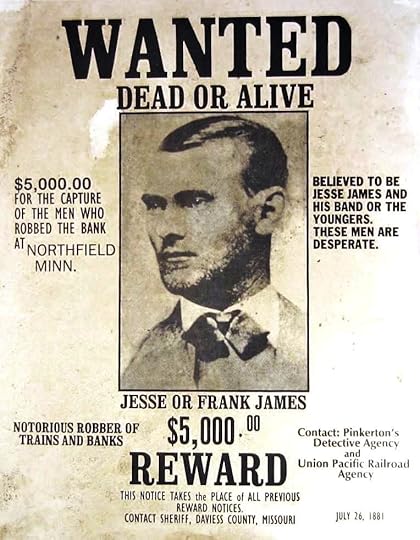
The hunt came to a fatal end in 1875, when the Pinkertons raided Zerelda James’ Clay County home. Tipped off, Frank and Jesse were long gone, but Zerelda stayed put for her boys. During the standoff between the Pinkertons and Zerelda, an incendiary device was tossed into the family home, blowing off part of Zerelda’s right arm, which later had to be amputated. Jesse and Frank’s younger half-brother was also a victim, dying in the attack.
Public opinion quickly turned on the Pinkerton Detective Agency and the war against the James gang was called off.
In Loving Memory
Jesse went on to evade authorities for another seven years before being assassinated in 1882. But, just like Jesse and Frank found their fortune robbing and stealing, their mother also knew how to make a quick buck in their name after death.
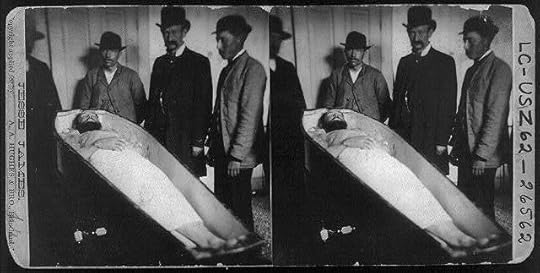
The viewing of Jesse James, 1882
Soon after Jesse was buried, Zerelda began giving tours of their home, even selling souvenirs. For 25 cents, visitors could buy a pebble from Jesse’s grave in the front yard. When the supply of rocks got low, Zerelda simply restocked them from a nearby creek.
Jesse’s epitaph read “In Loving Memory of my Beloved Son, Murdered by a Traitor and Coward Whose Name is not Worthy to Appear Here”.
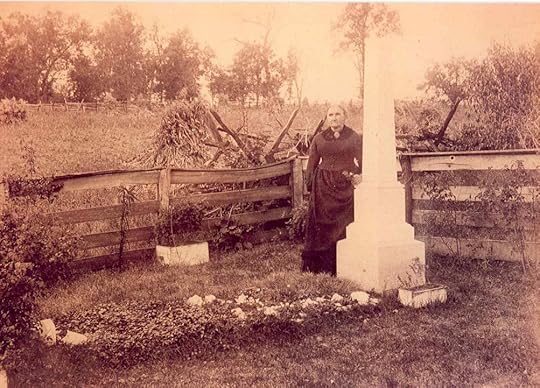
Zerelda at Jesse’s grave
The home’s gravesite no longer no contains Jesse’s remains, as he was moved to Mt. Olivet Cemetery in Kearney, Missouri in 1902, but Clay County still promotes the James family home. Charging $6.50 to tour the Jesse James Farm and Museum, visitors can still purchase a pebble for just 25 cents!
Source: Zerelda James, An Unbelievable Case of Motherly Love
The Rare and Deadly Sawfish Rostrum
Featured in Ripley's Believe It or Not!

A strikingly curious sight, sawfish look exactly like the fish their name would suggest. Their elongated noses, known as rostrums, are lined with sharp teeth.
There are only five species of sawfish in the world—Dwarf, Knifetooth, Smalltooth, Largetooth and Green sawfish. The largest being the smalltooth sawfish, which can grow up to 25 feet!
The function of these bills was once unconfirmed. Zoologists long thought they used them to sort through murky waters, sussing through seafloor detritus to find prey. After a series of tests performed by researchers from the University of Queensland, they observed freshwater sawfish using the sensory organs along their rostrum to locate and dismember prey. The fish’s saw was so effective that it would sometimes cleave a fish completely in two. They now believe sawfish use their tooth-lined weapons to slash at schooling fish or even cut tissue off of whales.
This behavior is different from other fish with rostrums—like sturgeon and swordfish. These fish either use their bills to sense prey or to dismember it. The sawfish is special for doing both jobs with its nose.
Due to this unique morphology, combined with slow growth, all five species of sawfish are listed as endangered or critically endangered.
Weapons
Revered throughout the world as a tool for shamans to ward off evil spirits, tribes in the Philippines, New Guinea, and New Zealand are known for carrying the tooth-lined rostrums into battle as vicious weapons.
By the 19th-century, world travelers and collectors began collecting sawfish rostrum in greater numbers. Eventually ending up in assorted wunderkammer or private collections, the beak was seen as an oddity of the ocean.
Though the Ripley’s collection houses a number of these fascinating objects, ones like the one we showcase here are antiques from the 1800s. The only new sawfish rostrums we have in our collection belong to the living sawfish at our world-famous Aquariums.
CARTOON 04-03-2018
April 2, 2018
Wilbur D. May’s Cabinet of Curiosities, Inside The Wunderkammer
Featured in Ripley's Believe It or Not!

In the mid-sixteenth century, Wunderkammer (or Cabinets of Curiosity), popped up across Europe. Receptacles of exotic objects and natural history specimens, they fascinated audiences by regaling them with finds from the four corners of the globe. Centuries later, the tradition continues at the Wilbur D. May Museum in Reno, Nevada.
Northern Nevada’s ultimate Wunderkammer, the museum houses wondrous curiosities and collectibles including Chinese snuff boxes, African tribal masks, Polynesian fertility talismen, Japanese swords, and hand-blown Venetian glass. Spanning more than sixty years of adventure, the collection blends fin-de-siècle decadence with twentieth-century wanderlust.
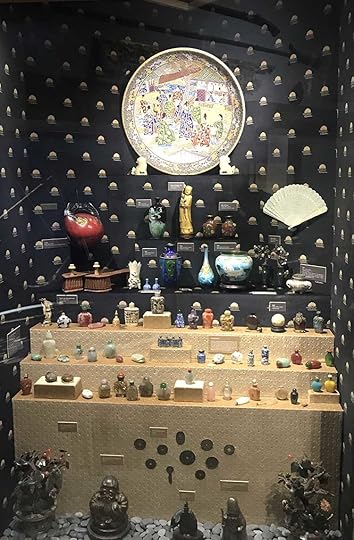
Chinese snuff boxes.
Wilbur D. May
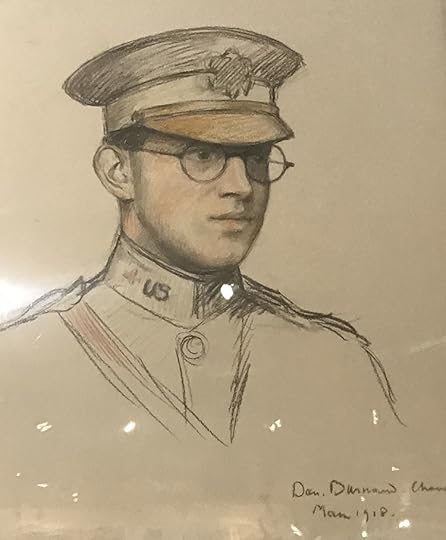
Wilbur D. May
Wilbur D. May (1898-1982) proved equal parts Paul Gauguin, Theodore Roosevelt, and Ernest Hemingway. He played nearly every iconic role of the twentieth century: athlete, soldier, pilot, big game hunter, millionaire, songwriter, rancher, adventurer, and painter.
His sojourns started in 1914 with the outbreak of World War I. At the age of 16, May ran away from home to join British forces headed to the Western Front. Stymied by his age and nationality, May could only find work driving ambulances.
When the US officially entered the war in April 1917, he enlisted in the expeditionary forces moving up the ranks to Major by the 1918 Armistice. Later that year, May returned to America diving headlong into aviation history.
He purchased a Ryan Monoplane with a Wright Whirlwind engine and soon logged more than 6,000 flight hours. At the time, the only aviators in the country with more flight hours were mail pilots. During the golden age of aviation, May quickly earned a reputation as one of the most skilled airmen in the United States.
In 1929, May went on his first African safari. He hired world-renowned guide Sir Denys Finch Hatton (played by Robert Redford in the movie Out of Africa) to lead him on this first of many big game hunts. Finch Hatton had just returned from another expedition with the Prince of Wales.
Since May knew he’d be out of the country for more than a year, he pulled all of his investments out of the stock market and poured them into Government Bonds. As a result, he narrowly avoided the 1929 stock market crash and found himself independently wealthy after his return from the safari.
During World War II, May flew dangerous reconnaissance missions over Alaska. After surviving a plane crash, he left the military ready to launch into other pursuits including painting, songwriting, world traveling, trophy hunting, and ranching. He also owned the 2,600-acre Double Diamond Ranch, just south of Reno, known for its prize herd of purebred Black Angus cattle.
The collection that May amassed speaks to his roving curiosity, countless pursuits, and fascination with indigenous cultures and natural history. One of the most astounding exhibit spaces is a recreation of May’s trophy room. The chamber contains nearly 200 pieces of taxidermy including countless heads and upper torsos, bear and big cat rugs, elephant-foot trash cans, zebra leg lamps, and a table and chairs fashioned from horns.

Museum curators have organized May’s finds geographically, allowing visitors to walk from North America to Europe, then on to Africa, India, Asia, and the South Pacific. Of the pieces displayed, May’s personal favorite is also one of the rarest: a tsantsa or shrunken head from the Jivaro tribe.
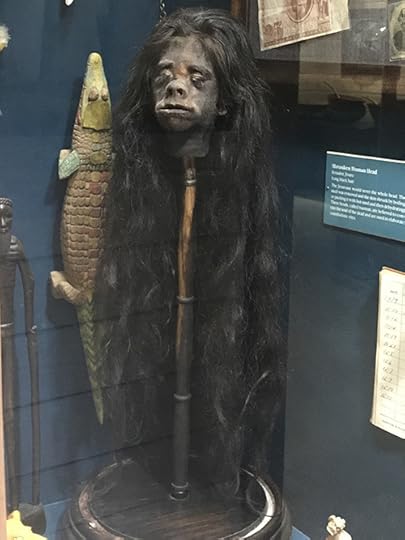
Because of the shrunken head’s long black hair and lush eyelashes, May named it after an ex-girlfriend, Susie. He reportedly paid his ranch foreman $5.00 per month to keep its mane neatly brushed and presentable. But curators have since determined that the original owner was male and have rechristened him “Fred.” May would be relieved to know that Fred’s hair remains luxurious.
Few men of the late nineteenth and early twentieth centuries better symbolized this age than Wilbur D. May. May’s eclectic Wunderkammer of globetrotting artifacts continues to tantalize and intrigue visitors.
By Engrid Barnett, contributor for Ripleys.com
Source: Wilbur D. May’s Cabinet of Curiosities, Inside The Wunderkammer
CARTOON 04-02-2018
April 1, 2018
CARTOON 04-01-2018
March 31, 2018
CARTOON 03-31-2018
March 30, 2018
Police Use Deceased People’s Fingers To Unlock Phones
Featured in Ripley's Believe It or Not!

[March 25-31st, 2018] An owl ring-bearer, lonely karaoke, a surprise mummy, and dead fingers unlocking phones in this week’s Weird News!
This Wedding Was A Hoot
Wanting to put a spin on the traditional best man pocket fumble, Jeni Arrowsmith and Mark Wood decided to use a live owl as a ring bearer at their Cheshire, England, wedding. The owl’s handler had enough trouble getting the bird to fly down the aisle, but the rings were safely delivered, albeit a lot of flapping. When the best man decided to point at the bird, however, it attacked him.
Here’s a photo from yesterday’s wedding the owl ring bearer making the best man scream @Peck1 #WeddingDayChat pic.twitter.com/dIVVbIbpmy
— Stacey Oliver Photos (@Staceyoliver13) March 18, 2018
Solo Karaoke Booths
If you like to sing but are rebuked by friends for your choppy breathing and tone-deaf delivery, take heart in the launch of solo karaoke booths in China. Meant for one, you can belt to your heart’s content without anyone judging you. Best of all, you don’t have to hear how good the person after you is.

Mummy Found in “Empty” Coffin
When a 2,500-year-old mummy arrived at the University of Sydney’s museum in 1860, curators didn’t bother to check inside, because the delivery form noted it was empty. Nearly 160 years later, they cracked it open and got a surprise. It indeed contained a mummy. Researchers believe the mummy inside is that of a 6th century BC noblewomen serving at the Temple of Sekhmet.
Orange Snow
The snowy white tundra of Russia is known to be sparklingly white, but a mysterious phenomenon has turned it orange. Not the result of anything dangerous or sinister, the orange residue is actually sand from the Sahara, carried across continents by a violent sandstorm in the region.
A post shared by Сочи • Красная Поляна (@sochi_) on Mar 23, 2018 at 1:20pm PDT
Dead Fingers Unlock Phones
In November 2016, hours after a man went on a killing spree and was shot dead by police, authorities pressed the dead man’s finger to his phone, hoping to unlock it and potential leads. Their attempt didn’t work, but according to Forbes, police departments confirm using the fingers of corpses to unlock phones. Investigators working with local and Federal investigations in Ohio and New York, for example, said they had used dead fingers to unlock the phones of overdose victims to try and locate a dealer.

Source: Police Use Deceased People’s Fingers To Unlock Phones
Just Two Classy Ladies Dueling to First Blood Over Flowers…Topless
Featured in Ripley's Believe It or Not!

It was 1892 and preparation for the Vienna Musical Theatrical Exhibition was underway. Austrian nobles Princess Pauline von Metternich and Countess Anastasia Kielmansegg seemed to be butting heads over flowers for the event.
Both classy and refined ladies, they were willing to shed blood to maintain proper etiquette and decided to squash their beef with a duel—fighting to first blood!
Duels Gone Wild
Overseeing the duel was Baroness Lubinska, ahead of her time in germ theory, she advised the women to remove one element from the equation in order to prevent infection—their shirts.
The Baroness, with a medical degree from a university in Poland, encouraged the women to fight topless for practical reasons, of course. Many dueling injuries at the time became infected due to strips of clothing being forced into a wound via weaponry.

Our victor, Princess Pauline von Metternich.
First Blood
The weapon of choice was Europe’s oldest dueling sword, the rapier, intended for quick stabs and little harm.
The duel went on for three rounds, in which the Countess nicked the Princesses’ nose. She then retaliated, drawing blood on the countess’ arm. After examining the wounds, the Princess was pronounced the victor.
This classy cat fight went down in history as the first emancipated duel because it involved female participants, female seconds and a female medic!
Source: Just Two Classy Ladies Dueling to First Blood Over Flowers…Topless
Ripley Entertainment Inc.'s Blog
- Ripley Entertainment Inc.'s profile
- 52 followers



